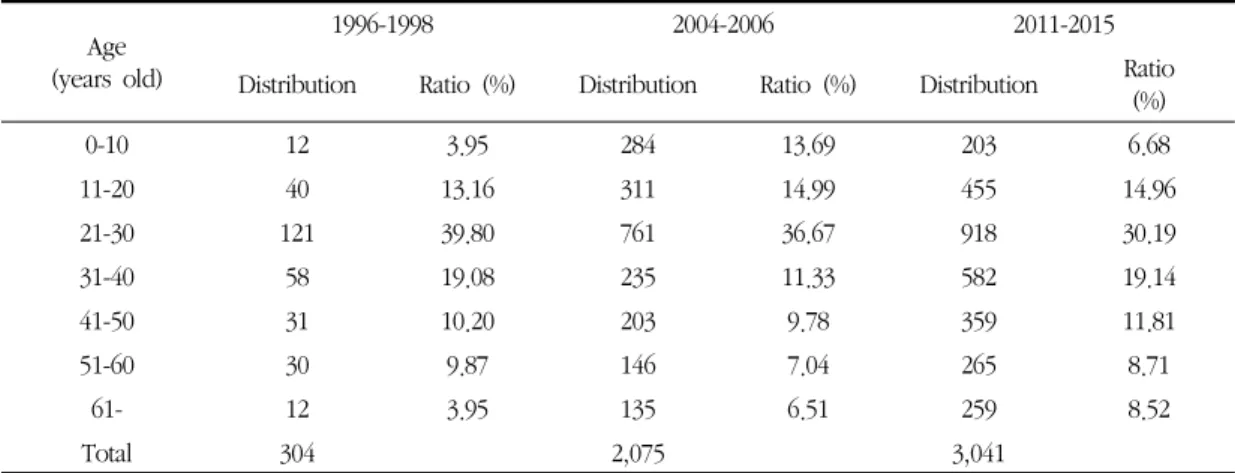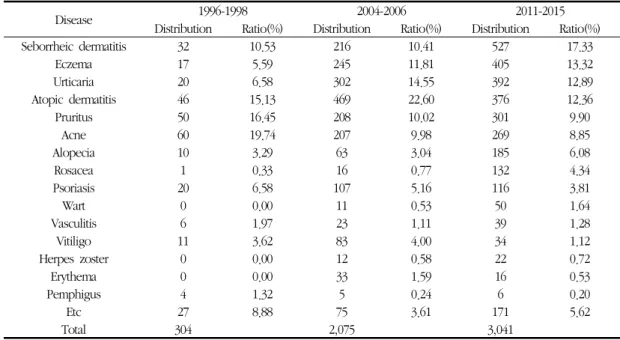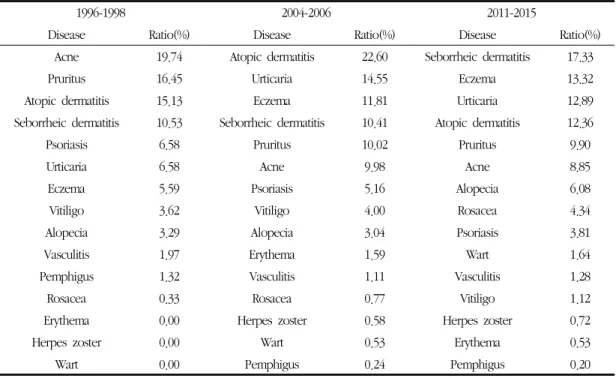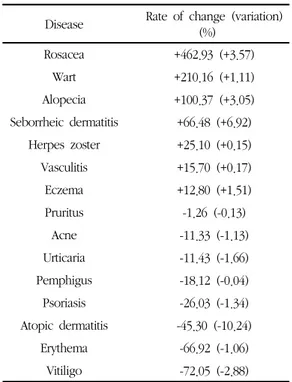pISSN 1738-6640 eISSN 2234-4020 http://dx.doi.org/10.6114/jkood.2016.29.3.050
Original Article / 원저
2011-2015년 경희대학교 한방병원 한방피부과 외래환자에 대한 통계적 분석
정우열·문영균·강세현·김규석·남혜정·김윤범* 경희대학교 한의과대학 안이비인후피부과
A Statistical Analysis of Outpatients in Dermatology of Korean Medicine at Kyung Hee University Korean Medicine Hospital in 2011-2015
Woo-Yeol Jeong·Young-Kyun Moon·Se-Hyun Kang·Kyu-Seok Kim·Hae-Jung Nam·Yoon-Bum Kim
*Department of Ophthalmology, Otolaryngology and Dermatology of Korean Medicine, College of Korean Medicine,
Kyung Hee University
Abstract
Objectives : This study was performed to find out the characteristics of outpatients and diseases in dermatology of Korean medicine and compare to previous studies.
Methods : We reviewed the medical records of total 3,041 outpatients in dermatology of Korean medicine at Kyung Hee Korean medicine hospital from January 1, 2011 to December 31, 2015. We found out demographic characteristics of outpatients and observed the diseases in order of frequency by age and sex. Then, we compared these results to previous studies performed at same hospital in 2000 and 2007.
Results and Conclusions :
1. Among the total 3,041 outpatients in 2011-2015, male patients were 1,184(38.87%) and female patients were 1,857(61.07%).
2. There were 203(6.68%) patients in 0-10 years old, 455(14.96%) patients in 11-20, 918(30.19%) patients in 21-30, 582(19.14%) patients in 31-40, 359(11.81%) patients in 41-50, 265(8.71%) patients in 51-60, and 259(8.52%) patients in more than 61 years old.
3. The common diseases in 2011-2015 were seborrheic dermatitis(17.33%), eczema(13.32%), urticaria(12.89%), atopic dermatitis(12.36%), pruritus(9.90%), acne(8.85%), and alopecia(6.08%).
ⓒ 2016 the Society of Korean Medicine Ophthalmology & Otolaryngology & Dermatology
This is an Open Access journal distributed under the terms of the Creative Commons Attribution Non-Commercial License (http://creativecommons.org/license/by-nc/3.0/) which permits unrestricted non-commercial use, distribution, and reproduction in any medium, provided the original work is properly cited.
Ⅰ. 서 론
현대사회에서 피부 질환은 그 관심도가 점차 증가 하고 있으며, 피부 질환의 발생률 또한 증가하고 있다
1). 이에 점차 확대되고 있는 피부과 영역에서 한의학 의 역할과 앞으로 나아갈 방향에 대한 고민을 바탕으 로 경희대학교 한방병원 안이비인후피부과에서는 외 래 환자 분석 연구를 수년 마다 수행해왔다2,3). 타 기 관에서도 유사한 연구들이 있었으나4-7), 2010년 이후 의 환자를 대상으로 한 연구는 없었으며, 동일 기관에 서 수년 단위의 반복적 연구를 통해 환자 분포 변화 를 살펴본 연구는 없었다.
이에 의무기록을 바탕으로 2011년부터 2015년 동 안의 한방피부과 환자의 최근 현황을 파악하고, 이를 경희대학교 한방병원에서 시행된 과거의 연구들2,3)과 비교하여 변화 양상을 살펴보고자 한다.
Ⅱ. 연구 대상 및 방법
1. 연구 대상
2011년 1월 1일부터 2015년 12월 31일까지 경희대 학교 한방병원 한방피부과 외래를 내원한 전체 신환
3,041명을 대상으로 하였다.
2. 연구 방법
외래 전자의무기록 및 의무기록지를 바탕으로 환자 들의 성별, 초진 당시 연령, 진단명을 조사하였으며, 진단명이 두 가지 이상인 경우 가장 중요한 하나의 질환을 선택하였다. 또한 2000년2), 2007년3)의 연구에 서 제시한 질환 분류 방법과 동일하게 적용하여, 이를 토대로 1996-1998년, 2004-2006년의 질환 분포 양상 과 비교하였다.
아토피피부염과 지루피부염은 습진의 범주에 포함 되지만 진단 빈도가 높아 독립적으로 집계하였으며, 접촉피부염, 화폐상습진, 건성습진, 한포진, 접촉피부 염 등은 습진으로 묶어 집계하였다. 또한 모든 백분율 은 소수점 셋째 자리에서 반올림하여 표시하였다.
3. 윤리적 승인
본 연구는 경희대학교 한방병원 기관생명윤리위원 회의 심의 면제 승인를 받아 시행되었다(KOMCIRB- 160805-EX-039).
Ⅲ. 결 과
1. 성별 분포 및 전체 환자 수
2011년부터 2015년 사이에 내원한 전체 신환 3,041명 중, 남자가 1,184명(38.87%), 여자가 1,857
4. The most common diseases by age groups were atopic dermatitis(0-10, 11-20 years old), seborrheic dermatitis(21-30, 31-40, 41-50 years old), urticaria(51-60 years old), and pruritus(more than 61 years old).
5. The common diseases in male patients were seborrheic dermatitis(20.69%), atopic dermatitis(15.46%), and urticaria(12.25%) and female patients were seborrheic dermatitis(15.19%), eczema(15.13%), and urticaria(13.30%).
6. The most increasing disease in the distribution between 2004-2006 and 2011-2015 is rosacea(+462.93%), and the most decreasing disease is vitiligo(-72.05%).
Key words : Statistical analysis; Skin disease; Korean medicine
Corresponding author : Yoon-Bum Kim, Department of Ophthalmology, Otorhinolaryngology and Dermatology of Korean Medicine, College of Korean Medicine, Kyung Hee University, 23, Kyungheedae-ro, Dongdaemun-gu, Seoul, Korea.
(Tel : 82-2-958-9177, E-mail : kyb0517@khu.ac.kr)
∙
Recieved 2016/7/1∙
Revised 2016/8/9∙
Accepted 2016/8/16Sex 1996-1998 2004-2006 2011-2015 Distribution Ratio (%) Distribution Ratio (%) Distribution Ratio (%)
Male 113 37.17 809 38.99 1,184 38.87
Female 191 62.83 1,266 61.01 1,857 61.07
Total 304 2,075 3,041
Table 1. Distribution of Sex of Outpatients in Dermatology of Korean Medicine.
Age (years old)
1996-1998 2004-2006 2011-2015
Distribution Ratio (%) Distribution Ratio (%) Distribution Ratio (%)
0-10 12 3.95 284 13.69 203 6.68
11-20 40 13.16 311 14.99 455 14.96
21-30 121 39.80 761 36.67 918 30.19
31-40 58 19.08 235 11.33 582 19.14
41-50 31 10.20 203 9.78 359 11.81
51-60 30 9.87 146 7.04 265 8.71
61- 12 3.95 135 6.51 259 8.52
Total 304 2,075 3,041
Table 2. Distribution of Age of Outpatients in Dermatology of Korean Medicine.
명(61.07%)으로 여자가 많았으며 성비는 그 이전 보 고들2,3)의 결과와 크게 다르지 않았다. 전체 피부과 환자 수는 1996-1998년 사이 연 평균 101.33명에서 2004-2006년 연평균 691.67명으로 582.57% 급증하 였으며, 2011-2015년 사이에는 연평균 608.20명으로 12.07% 감소하였다(Table 1).
2. 연령분포
2011년부터 2015년 사이에 내원한 전체 신환 3,041 명 중, 0-10세는 203명(6.68%), 11-20세는 455명 (14.96%), 21-30세는 918명(30.19%), 31-40세는 582명 (19.14%), 41-50세는 359명(11.81%), 51-60세는 265명 (8.71%), 61세 이상은 259명(8.52%)으로 나타났다.
0-10세 환자의 점유율은 2004-2006년 사이 13.69%에서 2011-2015년 6.68%로 51.23% 줄어들어 가장 큰 감소폭을 나타낸 반면, 31-40세 환자의 점유
율은 2004-2006년 사이 11.33%에서 2011-2015년 19.14%로 68.99% 늘어나 가장 큰 증가폭을 나타냈 다. 또한 30세 이하 그룹의 점유율은 모두 감소하였 으나 31세 이상 그룹의 점유율은 모두 증가하였으며, 특히 61세 이상 환자의 비율은 1996-1998년부터 꾸 준히 크게 증가하고 있음을 확인할 수 있다(Table 2).
3. 질환 분포
2011년부터 2015년 사이에 내원한 전체 신환 3,041명의 병명을 분석한 결과, 지루피부염 527건 (17.33%), 습진 405건(13.32%), 두드러기 392건 (12.89%), 아토피피부염 374건(12.36%), 가려움증 301건(9.90%), 여드름 269건(8.85%), 탈모 185건 (6.08%), 주사 132건(4.34%), 건선 116건(3.81%), 사 마귀 50건(1.64%), 혈관염 39건(1.28%), 백반증 34건 (1.12%), 대상포진 22건(0.72%), 홍반 16건(0.53%),
Disease 1996-1998 2004-2006 2011-2015 Distribution Ratio(%) Distribution Ratio(%) Distribution Ratio(%)
Seborrheic dermatitis 32 10.53 216 10.41 527 17.33
Eczema 17 5.59 245 11.81 405 13.32
Urticaria 20 6.58 302 14.55 392 12.89
Atopic dermatitis 46 15.13 469 22.60 376 12.36
Pruritus 50 16.45 208 10.02 301 9.90
Acne 60 19.74 207 9.98 269 8.85
Alopecia 10 3.29 63 3.04 185 6.08
Rosacea 1 0.33 16 0.77 132 4.34
Psoriasis 20 6.58 107 5.16 116 3.81
Wart 0 0.00 11 0.53 50 1.64
Vasculitis 6 1.97 23 1.11 39 1.28
Vitiligo 11 3.62 83 4.00 34 1.12
Herpes zoster 0 0.00 12 0.58 22 0.72
Erythema 0 0.00 33 1.59 16 0.53
Pemphigus 4 1.32 5 0.24 6 0.20
Etc 27 8.88 75 3.61 171 5.62
Total 304 2,075 3,041
Table 3. Distribution of Diseases of Outpatients in Dermatology of Korean Medicine.
0-10 years old 11-20 years old 21-30 years old
Disease Ratio(%) Disease Ratio(%) Disease Ratio(%)
Atopic dermatitis 44.83 Atopic dermatitis 25.05 Seborrheic dermatitis 22.66
Eczema 15.27 Acne 18.90 Acne 16.23
Wart 9.36 Seborrheic dermatitis 13.41 Atopic dermatitis 14.27
Pruritus 6.40 Urticaria 10.11 Eczema 10.35
Urticaria 6.40 Eczema 9.45 Urticaria 9.48
31-40 years old 41-50 years old 51-60 years old
Disease Ratio(%) Disease Ratio(%) Disease Ratio(%)
Seborrheic dermatitis 21.31 Seborrheic dermatitis 18.94 Urticaria 19.62
Urticaria 17.70 Eczema 17.83 Eczema 18.49
Eczema 14.78 Urticaria 13.93 Pruritus 15.85
Pruritus 10.14 Pruritus 10.31 Seborrheic dermatitis 12.45
Alopecia 7.22 Rosacea 8.64 Alopecia 8.68
61- years old
Disease Ratio(%)
Pruritus 33.59
Urticaria 15.83
Eczema 14.29
Seborrheic dermatitis 11.58
Rosacea 3.86
Table 4. Distribution of Diseases in order of Frequency by Age of Outpatients in Dermatology of Korean Medicine in 2011-2015.
Male Female
Disease Ratio(%) Disease Ratio(%)
Seborrheic dermatitis 20.69 Seborrheic dermatitis 15.19
Atopic dermatitis 15.46 Eczema 15.13
Urticaria 12.25 Urticaria 13.30
Eczema 10.47 Acne 11.36
Pruritus 9.97 Atopic dermatitis 10.39
Alopecia 7.35 Pruritus 9.85
Psoriasis 5.15 Rosacea 5.71
Acne 4.90 Alopecia 5.28
Rosacea 2.20 Psoriasis 2.96
Vitiligo 1.69 Wart 1.62
Wart 1.69 Vasculitis 1.51
Vasculitis 0.93 Herpes zoster 0.81
Erythema 0.59 Vitiligo 0.75
Herpes zoster 0.59 Erythema 0.48
Pemphigus 0.17 Pemphigus 0.22
Table 5. Distribution of Diseases in order of Frequency by Sex of Outpatients in Dermatology of Korean Medicine in 2011-2015.
1996-1998 2004-2006 2011-2015
Disease Ratio(%) Disease Ratio(%) Disease Ratio(%)
Acne 19.74 Atopic dermatitis 22.60 Seborrheic dermatitis 17.33
Pruritus 16.45 Urticaria 14.55 Eczema 13.32
Atopic dermatitis 15.13 Eczema 11.81 Urticaria 12.89
Seborrheic dermatitis 10.53 Seborrheic dermatitis 10.41 Atopic dermatitis 12.36
Psoriasis 6.58 Pruritus 10.02 Pruritus 9.90
Urticaria 6.58 Acne 9.98 Acne 8.85
Eczema 5.59 Psoriasis 5.16 Alopecia 6.08
Vitiligo 3.62 Vitiligo 4.00 Rosacea 4.34
Alopecia 3.29 Alopecia 3.04 Psoriasis 3.81
Vasculitis 1.97 Erythema 1.59 Wart 1.64
Pemphigus 1.32 Vasculitis 1.11 Vasculitis 1.28
Rosacea 0.33 Rosacea 0.77 Vitiligo 1.12
Erythema 0.00 Herpes zoster 0.58 Herpes zoster 0.72
Herpes zoster 0.00 Wart 0.53 Erythema 0.53
Wart 0.00 Pemphigus 0.24 Pemphigus 0.20
Table 6. Distribution of Diseases in order of Frequency by Year in Dermatology of Korean Medicine.
천포창 6건(0.20%), 기타 171건(5.62%)으로 나타났다 (Table 3).
또한 나이 그룹에 따른 질환 분포를 분석한 결과, 0-10세 그룹에서는 아토피피부염(44.83%) 환자가 압 도적으로 많았으며, 다른 연령대와 달리 사마귀 (9.36%) 환자가 비교적 많은 것으로 나타났다. 11-20 세 그룹에서도 아토피피부염(25.05%)이 가장 많았으 며 여드름(18.90%), 지루피부염(13.41%) 순으로 높게 나타났고, 21-30세 그룹에서는 지루피부염(22.66%), 여드름(16.23%), 아토피피부염(14.27%) 순으로 나타 났다. 31-40세 그룹에서는 지루피부염(21.31%)과 두 드러기(17.70%) 환자가 많은 것으로 나타났으며, 이 연령대부터 가려움증(10.14%) 환자의 분포가 서서히 증가하기 시작하였다. 41-50세 그룹에서는 지루피부 염(18.94%), 51-60세 그룹에서는 두드러기(19.62%) 가 가장 많았으며, 61세 이상 그룹에서는 가려움증 (33.59%)이 가장 많은 분포를 보여 다른 연령 그룹에 비해 매우 높은 양상을 보였다(Table 4).
성별에 따른 다빈도 질환 분석에서는 남성 환자들 의 경우 지루피부염(20.69%), 아토피피부염(15.46%), 두드러기(12.25%), 습진(10.47%), 가려움증(9.97%) 순으로, 여성 환자들의 경우에는 지루피부염(15.19%), 습진(15.13%), 두드러기(13.30%), 여드름(11.36%), 아토피피부염(10.39%) 순으로 높은 분포를 보였다 (Table 5).
4. 연도별 질환 분포 변화
이전의 연구들을 토대로 질환 분포 양상을 비교한 결과, 1996-1998년에는 여드름(19.74%), 가려움증 (16.45%), 아토피피부염(15.13%) 순으로 높게 나타났 다가 2004-2006년 사이에는 아토피피부염(22.60%), 두드러기(14.55%), 습진(11.81%) 순으로 환자 수가 많았다(Table 6).
2004-2006년과 2011-2015년 사이에 가장 분포 비 율이 증가한 질환은 주사였는데, 2004-2006년에는 0.77%였으나 2011-2015년에는 4.34%로 무려 462.93%
증가하였다. 그 다음으로는 사마귀(+210.16%), 탈모 (+100.37%) 순으로 상승률이 높았고, 지루피부염 (+66.48%) 또한 크게 상승하여 2011-2015년 사이 최 다빈도 질환으로 나타났다. 반대로, 백반증 환자는 2004-2006년에 4.00%에서 2011- 2015년에는 1.12%
로 72.05% 감소하여 가장 큰 감소폭을 보였으며, 홍반 (-66.92%), 아토피피부염(-45.30%) 또한 감소폭이 큰 것으로 나타났다(Table 7).
Table 7. The Rate of Change in the Distribution of Diseases of Outpatients in Dermatology of Korean Medicine between 2004-2006 and 2011-2015.
Disease Rate of change (variation) (%)
Rosacea +462.93 (+3.57)
Wart +210.16 (+1.11)
Alopecia +100.37 (+3.05)
Seborrheic dermatitis +66.48 (+6.92) Herpes zoster +25.10 (+0.15) Vasculitis +15.70 (+0.17)
Eczema +12.80 (+1.51)
Pruritus -1.26 (-0.13)
Acne -11.33 (-1.13)
Urticaria -11.43 (-1.66)
Pemphigus -18.12 (-0.04)
Psoriasis -26.03 (-1.34)
Atopic dermatitis -45.30 (-10.24)
Erythema -66.92 (-1.06)
Vitiligo -72.05 (-2.88)
Ⅳ. 고찰 및 결론
2011년부터 2015년 사이에 내원한 전체 신환 3,041명을 분석한 결과, 남자 38.87%, 여자 61.07%
의 성비가 나타났으며 이는 기존 동일한 병원에서 시 행한 두 연구2,3)와 대동소이하였다. 또한 2009년부터
2013년 사이의 양방 피부과 외래 환자를 분석하는 연 구에서 남자 45.8%, 여자 54.2%로 보고한 것보다 여 성 환자 비율이 좀 더 높게 나타남을 알 수 있다8). 또한 연령 분포 분석에서는 이전 연구들2,3)과 비교 시, 0-10세 환자의 점유율이 큰 폭으로 감소하였는데 이는 본 병원 한방소아과에 소아청소년센터가 개설되 어 아토피피부염을 비롯한 일부 소아 피부질환 환자 들이 유출된 것이 가장 큰 이유라 생각한다. 61세 이 상 환자를 필두로 중장년층 환자의 점유율은 꾸준히 증가하였는데 이는 고령화 사회로 나타난 결과로 여 겨지며, 필연적으로 모든 사람은 나이를 들어감에 따 라 노화로 인한 다양한 피부의 병리적 변화들이 야기 되므로9) 앞으로도 중장년층 피부 환자의 비율은 점점 증가할 것으로 예상된다.
2011년부터 2015년 사이의 다빈도 질환 분석에서 는 지루피부염, 습진, 두드러기, 아토피피부염, 가려움 증의 순으로 나타났으며, 이는 2015년 보건의료 빅데 이터 개방시스템의 한방 의료기관 다빈도 질병 통계 자료에서 피부 질환의 경우 아토피피부염, 기타피부 염, 두드러기, 지루피부염, 가려움증, 건선 순으로 나 타난 것과는 차이가 있다10). 이는 본 연구가 대학병원 에서 이루어 졌다는 점과 한방피부과 환자만을 대상 으로 하였기에 나타난 결과로 여겨지며, 한방소아과 의 피부질환군을 포함하여 연구한다면 좀 더 유사한 결과가 나타날 것으로 예상한다. 또한 2015년 양방의 료기관의 피부 질환의 경우 알러지성접촉피부염, 두 드러기, 백선증, 기타피부염, 자극물접촉피부염, 피부 농양 및 종기 순으로 환자 수가 많았던 것을 미루어 볼 때10), 한방의료기관의 피부과 질환군이 좀 더 비감 염성이며 만성적인 경과를 나타내는 질환임을 알 수 있다. 습진의 경우 독립적으로 집계한 아토피피부염, 지루피부염을 제외한 405건 중에서 상세불명의 습진 이 216건으로 가장 많았고, 한포진(85건), 접촉피부염 (75건), 화폐상습진(22건), 건조습진(7건) 순으로 나타 났다. 건조습진의 경우에는 가려움증으로 진단된 케 이스도 다수 있을 것으로 사료된다. 171건의 기타 질
환에서는 백선증(24건)과 과다색소침착증(21건), 구순 및 구순주위염(13건)이 많은 분포를 나타냈다.
연령에 따른 다빈도 질환 분석에서는 각 질환의 호 발연령과 다소 일치하는 결과가 나타났다. 아토피피 부염은 영유아 및 청소년기 환자가 많았으나 21-30세 (14.27%), 31-40세(5.67%) 그룹에서도 다수의 환자가 속하였으며 이러한 성인 아토피피부염 환자는 점차 늘어나는 추세에 있다11,12). 여드름 또한 청소년기뿐만 아니라 21-30세 그룹(16.23%)에서도 높은 점유율을 보이고, 성인 여드름 환자가 증가하고 있는 추세라는 점에서13) 앞으로도 지속적인 관찰이 필요할 것이다.
사마귀 환자는 0-10세 그룹(9.36%)에서 비교적 높은 빈도로 나타났으며 이는 학동기에 유병률이 높은 질 환의 특성이 반영된 것으로 사료된다14). 가려움증 환 자의 점유율은 중노년층 그룹에서 높게 나타났고 61 세 이상 그룹에서는 최다빈도 질환으로 나타났는데, 이는 노화로 인한 피지 분비 감소와 피부장벽기능 손 상에 의해 건조증 환자가 증가하기 때문이라 생각한 다15). 지루피부염, 습진, 두드러기는 비교적 넓은 연 령대에서 높은 분포를 보였다.
성별에 따른 다빈도 질환 분석에서는 남녀 모두 지 루피부염(남자 20.69%, 여자 15.19%)의 환자 비율이 가장 높았으며 남성 지루피부염의 점유율이 더 높은 것은 남성에게 호발하는 질환의 특성이 반영된 것으 로 판단된다16). 또한 남성 환자들의 경우 아토피 피부 염(15.46%), 가려움증(9.97%), 탈모(7.35%), 건선 (5.15%)의 분포가, 여성 환자들의 경우 습진(15.13%), 여드름(11.36%), 주사(5.71%), 혈관염(1.51%)의 분포 가 비교적으로 높게 나타났다. 여드름과 주사의 경우 에는 여성에서의 점유율이 남성에 비해 압도적으로 높았는데, 이는 두 질환 모두 여성에게 호발하는 질환
이며17,18), 미용 상으로도 큰 손해를 끼치는 질환이기
때문이라 생각한다.
2004-2006년과 2011-2015년 사이의 분포 양상을 비교한 결과, 주사(+462.93%), 사마귀(+210.16%), 탈 모(+100.37%), 지루피부염(+66.48%)의 점유율이 크
게 늘어났다. 주사 및 지루피부염은 안면부에 다발하 는 질환의 특성 상 적극적인 스테로이드 치료가 힘들 며, 만성적이고 자주 재발하는 경과로 인해 오랜 기간 양약에 의존해야 한다는 점에서 한방치료에 대한 수 요가 늘어난 것으로 생각하며, 본 과에서 시행하고 있 는 한약 및 침 치료 프로그램 또한 효과적으로 작용 한 결과로 생각한다. 사마귀 또한 냉동치료를 비롯한 기존 치료에 반응하지 않거나 지속적으로 재발하는 환자들이 있으며 한약, 약침, 침, 뜸 등의 한방치료가 유의한 효과들을 나타내고 있어 환자 비율이 대폭 증 가한 것으로 사료된다19-21). 탈모 환자의 점유율은 두 배가량 증가하였는데 이는 한방피부과 내 탈모 클리 닉이 운영되어 많은 환자들이 유입된 것과, 한의학계 에서의 다양한 실험 연구들과 이를 바탕으로 한 임상 적 시도들이 효과적으로 작용한 결과로 나타난 것으 로 사료된다22-25).
본 연구는 최근 5년 동안의 한방피부과에 내원한 환자들의 인구학적 특징 및 질병 분포 현황을 밝히고, 동일한 병원에서 이루어진 두 연구들1,2)과의 비교를 통해 1996년부터 2015년까지의 큰 흐름을 대략적으 로 살펴볼 수 있다는 점에서 의의를 찾을 수 있다. 추 후 다른 한방의료기관들과의 공동 연구를 통해 더 큰 집단을 대상으로 자료를 수집하고 분석한다면 더욱 더 가치 있는 자료가 될 것으로 생각하며, 이러한 분 과별 환자 분석 연구는 점차 전문화 되어가는 한방의 료 시장에서 한의학의 영역을 확대하고 가치를 높이 는 일에 일조할 수 있을 것이라 생각한다.
References
1. Choi CM, Cho HR, Lew BL, Sim WY, Lee JY, Ahn KJ, et al. The Recognition of Skin Health and Diseases in Dermatologic Outpatients. Korean J Dermatol. 2010;48(3):
184-90.
2. Kim YB. A Statistics Study of Surgery, Ophthalmology & Otolaryngology. J Korean Med Ophthalmol Otolaryngol Dermatol.
2000;13(1):280-90.
3. Cha JH, Kim YB, Nam HJ. The stastical analysis of ophthalmology, otolaryngology, dermatology new outpatients. J Korean Med Ophthalmol Otolaryngol Dermatol. 2007;20 (3):169-80.
4. Jung SY, Seo HS. A clinical Analysis of Ophthalmology, Otorhinolaryngology &
Dermatology. J Korean Med Ophthalmol Otolaryngol Dermatol. 2005;18(2):51-61.
5. Son BK, Choi IH. A Clinical Study of According to Prevalence of Dermatoses in a Oriental Medicine Hospital of Gang-Dong Area in Seoul. J Korean Med Ophthalmol Otolaryngol Dermatol. 2007;20(3):161-8.
6. Jung ARNR, Hong SU. A Clinical Analysis of Out-Patient with Skin Disease. J Korean Med Ophthalmol Otolaryngol Dermatol. 2007;20 (2):151-60.
7. Ryu YJ, Kim JE, Kim JH, Kwon K, Seo HS.
The Statistical Study of Dermatoses Outpatients in Oriental Hospitals Located in Gangwon Province. J Korean Med Ophthalmol Otolaryngol Dermatol. 2010;23 (3):66-77.
8. Lee SY, Choi HG, Ro BI, Cho HK. A Statistical Study of Dermatoses in Goyang City (2009~2013). Korean J Dermatol. 2015;53(2):
106-12.
9. Choi IH. A Clinical Study on the Prevalence of Skin Diseases in Adult Patients-focused on an aging society. J Korean Med Ophthalmol Otolaryngol Dermatol. 2006;19(2):242-8.
10. Korean Health Insurance Review &
Assessment service. Statistics of frequent diseases from Healthcare Bigdata Hub. 2016.
Available from: URL:http://opendata.hira.or.
kr/op/opc/olapHifrqSickInfo.do
11. Park S, Bae JH. Fermented food intake is associated with a reduced likelihood of atopic dermatitis in an adult population (Korean National Health and Nutrition Examination Survey 2012-2013). Nutr Res. 2016;36(2):
125-33.
12. Weidinger S, Novak N. Atopic dermatitis.
Lancet. 2016;387(10023):1109-22.
13. Holzmann R, Shakery K. Postadolescent acne in females. Skin Pharmacol Physiol. 2014;
27(Suppl. 1):3-8.
14. Kilkenny M, Marks R. The descriptive epidemiology of warts in the community.
Australas J Dermatol. 1996;37(2):80-6.
15. White-Chu EF, Reddy M. Dry skin in the elderly: Complexities of a common problem.
Clin Dermatol. 2011;29(1):37.
16. Gupta AK, Madzia SE, Batra R. Etiology and Management of Seborrheic Dermatitis.
Dermatology. 2004;2008(2):89-93.
17. Collier CN, Harper JC, Cafardi JA, Cantrell WC, Wang W, Foster KW, et al. The prevalence of acne in adults 20 years and older. J Am Acad Dermatol. 2008;58(1):56-9.
18. Elewski BE, Draelos Z, Dréno B, Jansen T, Layton A, Picardo M. Rosacea - global diversity and optimized outcome: proposed international consensus from the Rosacea International Expert Group. J Eur Acad Dermatol Venereol. 2011;25(2):188-200.
19. Shin SH, Yun JM, Heo JE, Ko WS, Yoon HJ.
The Efficacy of Korean Medical Treatment for Recalcitrant Hand and Foot Warts with an Experience of Cryotherapy. J Korean Med Ophthalmol Otolaryngol Dermatol. 2015;28 (2):33-44.
20. Moon YK, Jeong WY, Shin JH, Kim YB, Nam HJ, Kim KS. Three Cases of Verruca Vulgaris Treated Mainly with Gwakhyang- jeonggisangamibang and Moxibustion. J Korean Med Ophthalmol Otolaryngol Dermatol. 2015;28(2):93-101.
21. Yun JM, Shin SH, Yoon HJ, Ko WS.
Combination Therapy with Gwakhyang- jeonggisangamibang and Sojangjeonggyeok for the Treatment of Verruca Plana. J Korean Med Ophthalmol Otolaryngol Dermatol.
2010;23(1):169-81.
22. Jang IW, Ko WS, Yoon HJ. The Latest Trends of Treatment for Alopecia. J Korean Med Ophthalmol Otolaryngol Dermatol.
2015;28(4):12-28.
23. Baek SY, Im CK, Kim KJ. Study on the literatures of alopecia experiments published in the journal of Korean medicine. J East-West Med. 2014;39(4):1-13.
24. Kim KR, Lee GR, Lee JM, Ryu JH, Yin CS.
Effect of Herbal Medicines Pharmacopuncture on Hair Growth, a Review of Animal Study Reports Published in Korea. The Acupuncture. 2014;31(1):139-48.
25. Lee SM, Yi TH, Keum DH. A Clinical Study on 80 Cases of Alopecia Patients in the Oriental Medicine Clinic. J Oriental Rehab Med. 2005;15(2):141-54.



